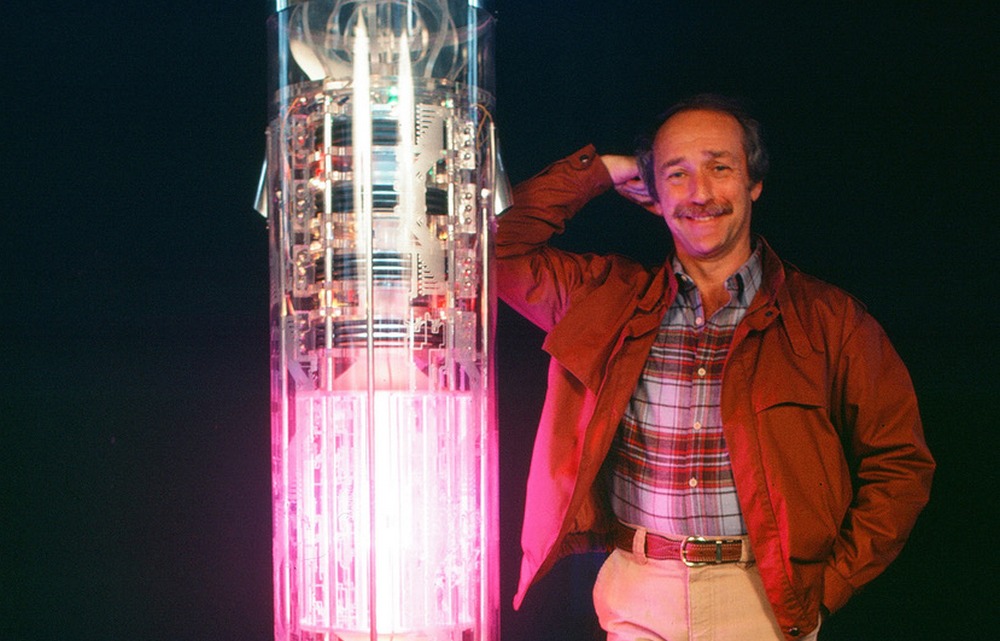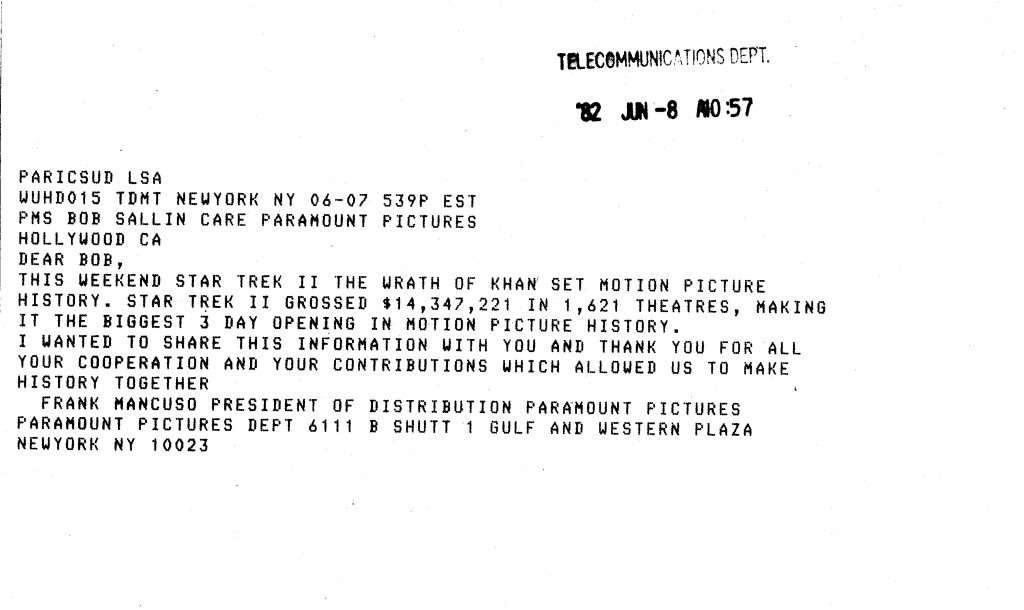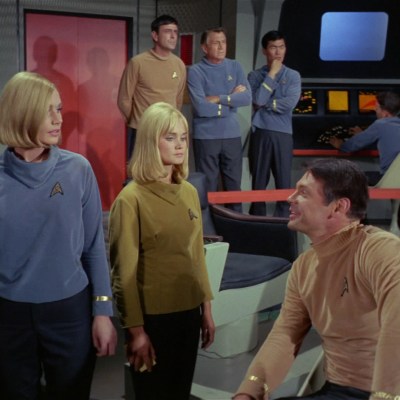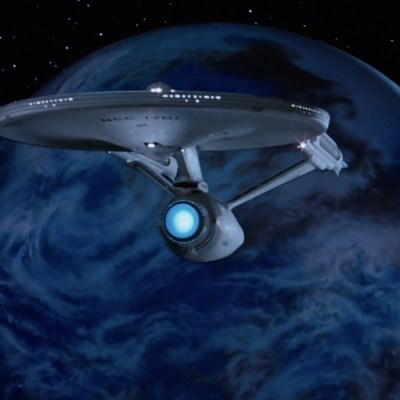To borrow a phrase, when it came to Star Trek circa 1980-1981, “it was the best of times, it was the worst of times.”
On the one hand, the arrival of Star Trek: The Motion Picture in 1979 had proven that audiences would show up for the big screen adaptation of a cult TV series that had gone off the air a decade earlier. The millions of fans who had never even seen the show in its original 1966-1969 run on NBC, but had caught it in syndication, were clearly hungry for more adventures with the crew of the U.S.S. Enterprise.
On the other hand, the negative critical response to that film and the incredible expense incurred in bringing it to the screen — its $44 million budget was the highest for a film made in the U.S. up to that time — had franchise owner Paramount Pictures rethinking its approach. With ST: TMP eking out a profit but on a somewhat tight margin, could additional movies be made on a more reasonable budget?
The answer to that question, Star Trek II: The Wrath of Khan, is still considered the gold standard of the Trek movie series some 38 years after it premiered in June 1982. A sequel to the 1967 original series episode “Space Seed,” it dealt with the return of Khan (Ricardo Montalban), a genetically enhanced superman from the 20th century who has a score to settle with Captain Kirk (William Shatner). The movie had Kirk and the crew grappling with issues of aging, memory, and grief, all while fighting to stay alive and keep a deadly new weapon out of Khan’s hands.
To develop the sequel, Paramount effectively sidelined Star Trek creator Gene Roddenberry, who had produced the first film and who had battled with the studio since the days of the TV show, and brought in veteran TV producer Harve Bennett. His mission was simple: to turn out a Star Trek sequel that was exciting and perhaps featured a bit more of the flavor of the series — instead of the cerebral, more esoteric exercise that ST: TMP turned out to be — all at a fraction of the first film’s cost.
Bennett and writer Jack Sowards worked on the story and initial drafts of the script, but since Bennett was also overseeing other projects at the same time, he needed someone on Star Trek II to act as the line producer — the person who would oversee all the myriad details of the production from prepping to post, and would also be the producer on the floor during the shoot.
He selected Robert Sallin, an old friend whom he had attended UCLA with. Sallin had successfully started his own company in which he produced and directed scores of commercials — but he had not worked on a major motion picture prior to this.
“Harve called me and said, ‘Hey, I got all these things to do. Do you want to produce Star Trek?’” recalls Sallin on the phone with Den of Geek. “I said, ‘Yes, why not?’ It was perfect timing. I just turned a key in my company, just walked away even though I had a building on Sunset and all kinds of stuff, and I went over to do this. I’m grateful that’s how he and I came together on that project.”

Sallin says that he and Bennett went “back to school” on Trek and learned the series — including the “restrictions” placed upon them by elements already established in the canon — in order to figure out the way forward. He also says that there were clearly mistakes made on Star Trek: The Motion Picture that would need to be rectified: “Most fundamentally — and this is a problem I have even today with a lot of science fiction — where was the humanity?” he says now about the Robert Wise-directed epic. “I want to tell a story that relates to human beings no matter where they are. I want to know about the human condition rather than a lot of mysticism.”
To tell that story, Sallin remembers sitting in a lot of meetings with Bennett and an ever-changing cast of writers who each gave their own pitches on the script — including one from Star Trek: The Original Series writer Samuel A. Peeples in which he replaced Khan completely with two powerful aliens named Sojin and Moray. “The stories, to be candid, they were just terrible,” says Sallin. “As the days went on, my concerns grew exponentially because it was not what I had hoped we would be doing.”
Even as the script was going through its contortions, Sallin was also tasked with finding a director for the film. “What I found in approaching people, number one, I think the biggest number of rejections came from the fact that they didn’t want to do Star Trek based on what they had seen from the first picture,” he tells us now while confirming that he had canvassed a vast number of filmmakers. “Number two, they didn’t want to do a sequel of any kind. Number three, they didn’t want to do science fiction. Number four, they weren’t available. I was astonished and I was looking at a number of directors.”
Among the 30 or 40 candidates he approached were a young Ron Howard (Cocoon) as well as several British directors — a safeguard against a looming Director’s Guild strike. One of those directors was Hugh Hudson, then making his feature debut with Chariots of Fire. “I had just been to a Directors Guild screening,” Sallin recalls. “I was telling the executives at Paramount and Harve, ‘This is so well done. It’s such a great story. A guy who knows how to do this, to tell this kind of story, would bring a whole new dimension to our Star Trek.’”
Sallin arranged a screening of Chariots for the Paramount execs. “The lights come on and everybody looks at me like I had stepped in something,” he recounts. “They looked at me like I was crazy…I wandered off after that screening shaking my head, thinking to myself, ‘I may be in the wrong business.’ They didn’t think that Hugh Hudson was good enough to direct Star Trek.” (Chariots of Fire won the 1981 Oscar for Best Picture.)
Sallin admits he was getting “more and more nervous” as the search for a director dragged on, until his assistant Deborah Arakelian suggested Nicholas Meyer, an acclaimed screenwriter and novelist who had directed his first film, Time After Time, in 1979. “I went over to see (Meyer) by myself,” says the producer. “We had a chat. I said, ‘Nick, what this is, is an opera in space with real people that we have to care about. We have to talk about the real human issues in addition to a really intriguing story that’s consistent with Star Trek and the canon.’”
Sallin remembers that Meyer got the concept for the film right away, which led to a second meeting, this time with Bennett participating as well.
“When we finished the meeting, as we’re walking out to our car, Harve turned to me and said, ‘He’s going to be trouble.’ I said, ‘What are you talking about?’ He said, ‘He’s going to be trouble.’ I didn’t understand at the time. Nick wasn’t really trouble, but Nick has a very strong persona and sense of self.”
Meyer came on board to direct and — in a now famous story — took the still-troubled script and did an uncredited rewrite on it in just 12 days. “His uncredited and unpaid rewrite that he did in 12 days is what saved this whole franchise,” marvels Sallin. “That was the key.”
Nevertheless, despite his success in finally pinning down the script for Star Trek II, Meyer quickly found himself in a quagmire once cameras began rolling.
Read more
“When we finished the first three days of shooting, we were a week behind schedule,” says Sallin. “I have to confess I panicked because this was so contrary to everything I’ve ever done or experienced. That’s just not the way I do things. When I’m directing, I’m on budget and I’m on time.”
Sallin admits that the idea of replacing Meyer crossed his mind.
“I called Harve first,” he recalls. “I said, ‘Harve, this is what’s going on. My instinct is I think we got to replace this guy.’ He said, ‘You do whatever you think.’ That wasn’t terribly helpful. I can’t remember who else I went to, but they said, ‘Do whatever you have to do.’ So I went to management and explained what was going on. They said, ‘We can’t fire him because then no one would want to work at Paramount.’ I said, ‘Fellas, it’s your money and if that’s what you want, I’m there’…Fortunately, Nick got his act together and went on.”
Sallin is quick to add that he has “nothing but respect for (Meyer) in terms of his talent,” and in fact Meyer himself described Sallin as “an enormously intelligent and tasteful guy” when asked who the “unsung heroes” of Star Trek II were in a 2017 interview. “Oh, that was very gracious of him,” says Sallin with sincerity. “That’s very gracious. I was the guy behind the curtain.”
Of course, Sallin had to navigate other larger-than-life personalities on the movie, including stars Shatner, Leonard Nimoy (Spock), and Montalban, but he insists that all three, as well as the rest of the regular and guest cast, were a pleasure through and through. “Working with everybody once they were all on board was really a delight,” he says. “I didn’t have one cross word with any of the cast. Bill was in a good mood once he came on board, Leonard was in a good mood, they’re constantly professionals, they were fine actors, and they know those roles better than anybody.”

As for the legendary Montalban, Sallin recollects, “It’s what any director dreams that an actor will be. He understood the character, he knew the place that character had in the structure of the story, he had all the skills and the talent, he had all the experience, and he was a gentleman to boot. I would sit with him between takes for days while he was there. He was just an absolute and total joy.”
Sallin also details an incident that occurred with the late James Doohan, who played the Enterprise’s beloved chief engineer Montgomery Scott.
“This idea of Spock dying was of course supposed to be a gigantic secret, which ultimately it did not become,” he explains. “I got a call from a certain member of management at Paramount saying, ‘We just heard that Scotty told somebody about Spock dying. We want him up here and we want to have a talk with him. We’re really going to chew his ass out.’”
But Sallin asked Paramount to dial it down — and for good reason. “I walked in the office and I said, ‘Look, fellas, you’ve got to understand something — he just had a heart attack,’” he says. “You’ve got to go easy on him if you want him in this picture because if you get him upset, we’re going to lose him.’ We did have the meeting, I brought (Doohan) up, but they were very kind and gentle with him about it.”
The death of Spock at the end of the movie — which was a major incentive to lure Leonard Nimoy back to the series after he initially refused to return — was indeed supposed to be a secret. Theories persist to this day that Gene Roddenberry himself leaked the ending to fandom as a way to sabotage the film after he had been removed from it by Paramount (Sallin says he had “minimal interaction” with the Star Trek creator during production). However the information got out, it caused major shock waves among Star Trek fans — and this was years before we had anything like the Internet to spread movie news.
Sallin says he did get “death threats” over the Spock news (not much has changed in 38 years, apparently, internet or not) and Paramount was so concerned over the blowback that it was determined that the movie had to end on a more hopeful note. “It was decided that we would create a little something at the end that was somewhat ambivalent, that left the door open to bring him back,” he says, noting that Nicholas Meyer “hated the idea.”
As fans know, a shot was inserted in which Spock’s coffin is seen resting on the newly created Genesis Planet, with the implication that the life-generating matrix which created the world may well have the same effect on the deceased Vulcan. It was Sallin who created and directed the shot.

“I went back to my old commercial days,” he elaborates. “I storyboarded this whole end sequence. I did a lot of it like a commercial…We shot it in (San Francisco’s) Golden Gate Park. We even added plants to make it look a little bit more exotic in terms of the foliage. I shot it and brought it back. Then my editor, Bill Dornisch, who used to be on staff with me at my commercial company, cut it, and he said, ‘Do you know how long that last shot you just did is?’ I go, ‘No.’ He said, ‘It’s 60 seconds.’ I said, ‘God, I can’t break my habits. I’m built to do everything in 30 or 60 seconds.’”
Spock’s death scene — even with the addition at the end — was a tremendously moving finale to what turned out to be an outstanding sci-fi adventure. Star Trek II: The Wrath of Khan opened on June 4, 1982 and almost immediately erased the lingering unease left behind by ST: TMP with its exciting story, renewed emphasis on the relationships between the characters, the triumphant return of Khan, and the emotional rollercoaster of its closing scenes.
Although its $97 million worldwide take at the box office was less than that of its predecessor, its $12 million budget ensured that the film was far more profitable, paving the way for a third movie and beyond. But Sallin himself did not return, deciding to walk away even though Paramount was interested in having him stay on as producer.
“I said, ‘What about Harve?’” explains Sallin now. “They said, ‘We want him doing television.’” Paramount’s reasoning was that Harve Bennett, who had brought Sallin onto Star Trek, was more lucrative to them as a television producer, and while Star Trek II was produced by the studio’s TV division, the next movie was going to be shifted back to the feature film department.

“My dilemma was, do I want to stay on and do this, and cut the legs off from the guy who brought me into the project?” says Sallin. “Despite the fact that Harve and I had some serious fallings out during the course of the production, particularly towards the end, I could have taken it, and he would have gotten bounced. I went to sleep that night, I came back the next morning, and I said, ‘I can’t do it’…I just couldn’t bring myself to do that no matter how angry I was with him.” (Bennett, who produced three more Trek movies, passed away in 2015.)
Sallin says that he has not kept up with the franchise since his exit (“I think I watched part of the third one…I was so appalled that I couldn’t go on with it. I thought it was an ugly looking picture”) but affirms that working on Star Trek II was “gratifying on so many levels.” And although he went into semi-retirement for a number of years, Sallin says that he’s recently been developing several new projects and even has his own idea for a new Star Trek movie.
Perhaps most importantly, his role in bringing Star Trek II: The Wrath of Khan to the screen — which truly did save the franchise and set it on a brand new course of success that lasts to this day on film and TV — helped Sallin understand just how important the original show and its message was and is to generations of devoted fans. “I had no idea when I came on board to do Star Trek what a profoundly important experience it is for so many people, how meaningful it is for so many people, and how the message resonates with so many people,” he says with wonder. “That was an eye opener for me.”


